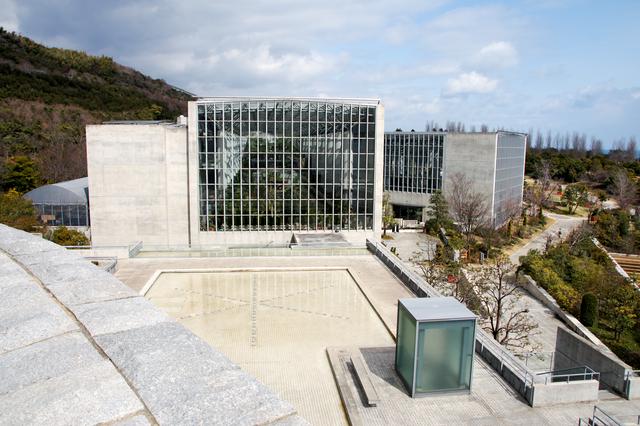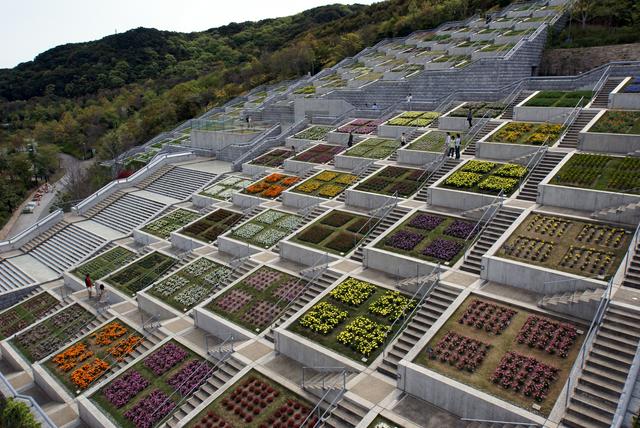Awaji Island (淡路島 Awajishima) is a not-terribly-large island - about the same size as Singapore - that marks the eastern boundary of the Seto Inland Sea of Japan. Thanks to a set of new bridges and a cross-island expressway, most visitors just zip through on their way from Honshu to Shikoku.
Awajishima has some claim to being the oldest settled area in Japan; the Kojiki mentions it under the name "Onokoroshima" and burial mounds (kofun) dating back thousands of years have been found on the island. The ningyo joruri puppet theater, which has evolved into bunraku, seems to originate from Awajishima.
Awajishima made a very unusual but brief appearance on the world stage as the epicenter of the Great Hanshin Earthquake of 1995 that killed over 6000 people. However, Awajishima was (and remains) far less built up than the suburbs of Kobe across the bay, which took the brunt of the damage. It was also the island where the England soccer team stayed during the World Cup in 2002.
The southern tip lies a mere kilometer off the coast of Shikoku, and a bridge now straddles the Naruto Strait, famed for the whirlpools that form as the tide flows in and out. The very name "Awaji" means "road to Awa", the former name of current Shikoku prefecture of Tokushima.
At the other end of the island, some 50 km away, the northern tip is not far from the port city of Kobe on Honshu, and the immense 3.5 km Akashi Kaikyo Bridge — the world's longest — now connects Awaji to the mainland. Politically (and in geographic terms somewhat oddly), despite its proximity to Shikoku, Awaji is a part of Honshu's Hyogo prefecture.

 Check out the beaches, especially on the more sparsely settled northern coast. They're a popular nearby summer getaway for Kansai-ites. There are also a number of hot springs (onsen), the best known of which are Awaji's largest town Sumoto and the mildly radioactive (!) waters of Iwaya adjacent to the northern bridge.
Check out the beaches, especially on the more sparsely settled northern coast. They're a popular nearby summer getaway for Kansai-ites. There are also a number of hot springs (onsen), the best known of which are Awaji's largest town Sumoto and the mildly radioactive (!) waters of Iwaya adjacent to the northern bridge.
Today's Awajishima is known primarily for its bridges and onions. The current total population hovers around 150,000, and (unlike most rural areas in Japan) is slowly on the rise due to the improved connections to the mainland. Scattered here and there are a number of herb and biwa (loquat) farms. The southern coast has a hideous but huge concrete statue of the Buddhist deity Kannon and the inevitable Onokoro Amusement Park.
- Akashi Kaikyo Bridge. Completed in 1998, this majestic bridge dwarfs the village of Iwaya below. The bridge's total length is 3,991 m, and the main span's length of 1,991 m makes it the longest suspension bridge in the world. The bridge is attractively lit at night.
- Naruto Whirlpools. See the whirlpools, either at the rest area on the expressway near Onaruto Bridge or by cruise.

- Sumoto Castle. A ruined castle and keep, reconstructed in concrete in 1928. Getting there requires quite a hike, but the view from the top is extraordinary.
- Water Temple. 09:00-17:00. A famous Buddhist temple building designed by Japanese architect Tadao Ando. The same architect also designed nearby Yume no Butai. ¥400.
- Nojima Fault Preservation Museum, +81 799-82-3020. A section of the Nojima Fault, responsible for the 1995 Great Hanshin earthquake, is preserved here.
- Kiseki no Hoshi Botanical Museum, +81 799-74-1200. A beautiful botanical museum.
Akashi Kaikyo Bridge. Completed in 1998, this majestic bridge dwarfs the village of [[Iwaya]] below. The bridge's total length is 3,991 m, and the main span's length of 1,991 m makes it the longest suspension bridge in the world. The bridge is attractively lit at night.
Naruto Whirlpools. See the whirlpools, either at the rest area on the expressway near Onaruto Bridge or by cruise.
Sumoto Castle. A ruined [[Japanese castles|castle]] and keep, reconstructed in concrete in 1928. Getting there requires quite a hike, but the view from the top is extraordinary.
Water Temple. 09:00-17:00. A famous Buddhist temple building designed by Japanese architect Tadao Ando. The same architect also designed nearby Yume no Butai. ¥400.
Nojima Fault Preservation Museum, +81 799-82-3020. A section of the Nojima Fault, responsible for the 1995 Great Hanshin earthquake, is preserved here.
Kiseki no Hoshi Botanical Museum, +81 799-74-1200. A beautiful botanical museum.
Awaji is famous for their onions, fish and cheese.
